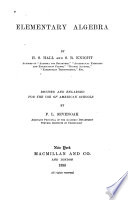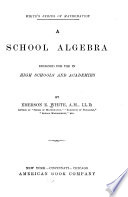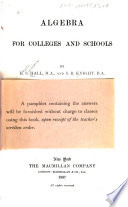 | Henry Sinclair Hall, Samuel Ratcliffe Knight - Algebra - 1895 - 508 pages
...as the next term in the root and in the divisor. We next multiply the complete divisor by the last term of the root and subtract the product from the last remainder. If there is now no remainder the root has been found ; if there is a remainder we continue the process.... | |
 | Henry Sinclair Hall, Samuel Ratcliffe Knight - Algebra - 1895 - 212 pages
...as the next term in the root and in the divisor. We next multiply the complete divisor by the last term of the root and subtract the product from the last remainder. If there is now no remainder the root has been found ; if there is a remainder we continue the process.... | |
 | Emerson Elbridge White - Algebra - 1896 - 418 pages
...multiplied by the second, and the square of the second; and then multiply the complete divisor thus formed by the second term of the root, and subtract the product from the remaining terms of the polynomial. Proceed in like manner until all the terms of the polynomial are.... | |
 | Henry Sinclair Hall, Samuel Ratcliffe Knight - Algebra - 1897 - 548 pages
...as the next term in the root and in the divisor. We next multiply the complete divisor by the last term of the root and subtract the product from the last remainder. If there is now no remainder the root has been found ; if there is a remainder we continue the process.... | |
 | George Washington Hull - Algebra - 1904 - 172 pages
...twice the root already found, and annex the quotient to the root, and also to the trial divisor to form the complete divisor. Multiply the complete divisor...term of the root, and subtract the product from the remainder. Continue in this manner until all the terms of the root are found. 2. Find the square root... | |
 | Herbert Edwin Hawkes, William Arthur Luby, Frank Charles Touton - Algebra - 1911 - 288 pages
...the first term and the second term of the root, and the square of the second term also, thus forming the complete divisor. Multiply the complete divisor by the second term of the root, and subtract the result from the remainder. If terms of the polynomial still remain, square the part of the root already... | |
 | John Charles Stone, James Franklin Millis - Algebra - 1911 - 698 pages
...the root. (4) Add this quotient to the trial divisor to obtain the true divisor, multiply the true divisor by the second term of the root, and subtract the product from the preceding remainder. (5) If there is still a remainder, double all of the root already found, for a... | |
 | William Benjamin Fite - Algebra - 1913 - 368 pages
...it to the last trial divisor to form a complete divisor. Multiply this complete divisor by the last term of the root and subtract the product from the last remainder. Continue this process until a zero remainder is obtained. EXERCISES Find the square roots of each of... | |
 | William Benjamin Fite - Algebra - 1913 - 304 pages
...to the last trial divisor to form a complete divisor. J\fultij>h/ this complete divisor by the last term of the root and subtract the product from the last remainder. Continue this process until a zero remainder is obtained. EXERCISES Find the square roots of each of... | |
 | Henry Sinclair Hall - 1918 - 382 pages
...as the next term in the root and in the divisor. We next multiply the complete divisor by the last term of the root and subtract the product from the last remainder. If there is now no remainder the root has been found ; if there is a remainder we continue the process.... | |
| |